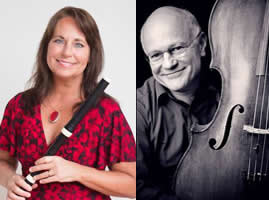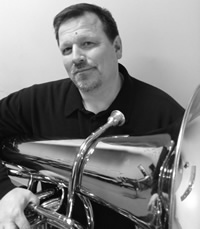For his November 16, 2002, recital on the Great Artists Series, presented by the NC Symphony with support from the A.J. Fletcher Foundation, Vladimir Feltsman, a Russian pianist now resident in the United States, played an intriguing program of works by Robert Schumann (1810-56) and Modest Mussorgsky (1839-81) comprised of Schumann’s little-played “Arabesque,” Op. 18, the well-known Carnaval , Op. 9, and Mussorgsky’s epic piano cycle Pictures at an Exhibition . Feltsman possesses great technical resources and an adventurous combination of intellectual rigor and improvisation in his musical approach, both of which were in evidence, although not always satisfactorily balanced, in this Fletcher Opera Theater recital.
Written in 1838 while Schumann was living in Vienna, the “Arabesque” is a charming five-part rondo in C with two contrasting minor key sections and a melancholy coda. Schumann joked that the piece was meant to capture the market for music aimed at amateur female pianists, a lucrative market for music publishers in the mid-19th century. This remark, like most jokes, is only half serious, but the music does reflect the intent with its significant, but not overwhelming, technical demands and its concentrated, but delicate, expressive quality. The music is characterized by a melodic pickup with a grace note that permeates almost every phrase in piece, and serves as a light-hearted example of Schumann’s tendency towards rhythmic obsessiveness. Feltsman dwelled a little too long on these pickups as the music progressed but otherwise played with the necessary delicacy and expressive variety.
Schumann’s Carnaval , a series of musical episodes and characters tied together by nothing more than the composer’s fanciful imagination, is unprecedented and stretches the boundaries of what can be termed a musical composition. It displays Schumann’s sense of humor, something possessed by few Romantic composers other than himself and Berlioz, with his love of musical structures inspired by literature and an imaginative take on the capabilities of the piano. Feltsman brought out the stirring waltz rhythms that permeate Carnaval and perfectly timed the transitions between episodes. The infectiously pompous “Preambule,” whose manic waltz episode is rife with characteristic two against three cross rhythms, was clearly etched. Schumann’s alter egos, the dreamy Eusebius and the passionate Florestan, both took their bows while the buoyant and difficult repeated notes of “Reconnaissance” bubbled over with enthusiasm. His playing of the Chopin episode, regarded by the touchy and humorless Chopin as parody rather than homage, took the composer’s Agitato marking to heart; the ornamentation of the melody during the repeat was entertaining if unnecessary. A canny “Valse Noble” framed the virtuosic pyrotechnics of Paganini and then the Davidsbündler, Schumann’s imaginary league of modern musicians fighting the philistines of musical conservatism, marched triumphantly in waltz time towards final victory, tromping on a 17th century tune along the way. Despite some smudged notes and a memory lapse in the first section of the final “March,” Feltsman maintained his intensity and commitment throughout.
Mussorgsky’s Pictures at an Exhibition is also a series of musical episodes linked by an extramusical idea, but without Schumann’s genuine humor and high spirits. Inspired by an 1874 St. Petersburg exhibition of work by his close friend, the artist Victor Hartmann, who died unexpectedly in 1873, the music is most familiar in Ravel’s orchestration, but the piano original conveys Mussorgsky’s raw power and creativity more directly than any of the orchestral versions. Feltsman began the opening “Promenade” at an overly fast tempo, sending the composer jogging through the exhibition. After an evocative “Gnomus,” disturbing rhythmic distensions of phrases, along with more smudged and missed notes, began to appear. The troubadour-like melody of “Il Vecchio Castello” was rhythmically micromanaged in a way that undercut the cumulative effect of its repetitions and a memory lapse in the third “Promenade” almost stopped the momentum altogether. However, the faster, technically brilliant sections, the speech-like chattering of “The Marketplace at Limoges,” for instance, were beautifully played. Feltsman effectively communicated the variety of moods found in the “Promenades” as well as the relationship between the melody of the opening “Promenade” and its transformed versions, “Con Mortuis in Lingua Mortua” and “The Great Gate of Kiev,” while managing transitions between sections expertly. His most egregious musical miscalculation occurred near the end when he played the first statement of the “Great Gate’s” ceremonial melody subito piano, an interpretive choice that rendered the rest of the movement anti-climactic by dissipating the momentum of the ascending scales that link the terrifying “The Hut on Fowl’s Legs” to “The Great Gate.”
This interpretation of Pictures left me ambivalent, alternately impressed and disturbed by Feltsman’s musical choices-an impression heightened by the pianist’s invitation to the audience to clap after his wonderfully played encore, Liszt’s transcription of the Schumann Lied, “Widmung.” This odd gesture suggested an artist somewhat dissatisfied with his performance of Pictures , which did not approach his inspired interpretation of Carnaval . Finally, the Great Artist Series organizers ought to provide program notes given the ticket prices charged for these concerts.












